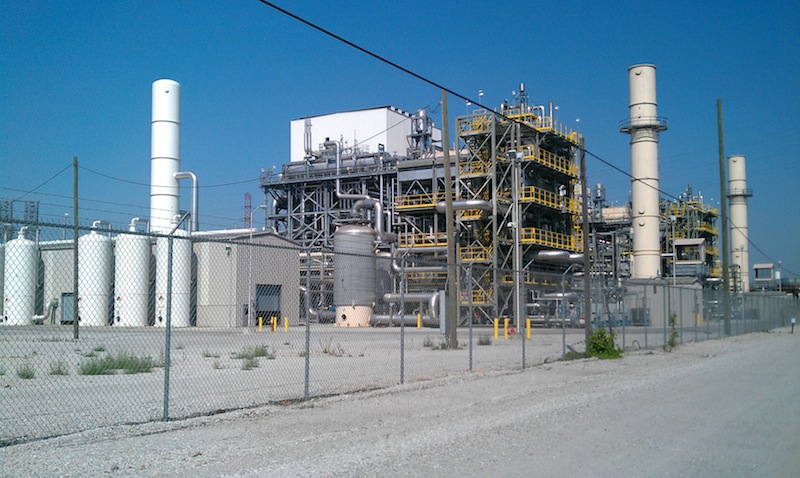Using a common integrated DCS, SCADA, and asset management platform at its hydrogen plants will help Praxair save on engineering, commissioning, and maintenance.

As the world’s largest producer of industrial gases, Praxair frequently builds production facilities at or adjacent to major customer sites to assure uninterrupted product delivery. For example, the company operates 40 hydrogen production facilities and seven hydrogen pipeline systems worldwide that deliver nearly one billion standard cubic feet of hydrogen per day to refineries, chemical plants, food plants, and other process industries that use high volumes of industrial gases.
Satellite plants like this help Praxair maintain a continuous supply of product to its customers, regardless of circumstances. And by standardizing the design of such plants, it is able to achieve efficient, disciplined project execution, which was exemplified in one of its recent facilities.
Praxair’s 200 million standard cubic feet per day hydrogen facility in Whiting, Ind., serves to demonstrate this strategy as it works to develop high operating efficiency and long-term reliability. In planning and constructing this large-scale hydrogen production facility to serve a nearby refinery, Praxair worked for the first time with a control system manufacturer, Emerson Process Management, to develop a DCS (distributed control system) to work with its SCADA (supervisory control and data acquisition) structure. The result was a DeltaV field automation system integrated with the SCADA structure used at Praxair’s other plants to extend process control to small packaged units.
Additionally, Praxair engaged Emerson to commission and start up the new production facility. This collaborative approach to system design, construction, testing, and project implementation produced a high level of execution efficiency. Some of this was attributed to the use of HART-enabled field devices that contributed to an easy start-up with a well-prepared operations and maintenance force ready to run the facility efficiently and with minimal intrusion. This approach will serve as a model for multiple projects in the future, saving money on engineering, instrumentation, start-up, operation, and maintenance.
Teamwork
Praxair and Emerson worked together on this project beginning with the FEED (front-end engineering and development) stage and continuing through design, documentation, testing, and implementation. Each project team had managers who became liaison persons as the production and control systems were developed simultaneously. The scope of the project was well-defined with a complete list of deliverables. Emphasis on planning and construction efficiency helped drive costs down on this and future projects.
Praxair’s process engineering group is accustomed to documenting design concepts in order to standardize production components and construction methods so that every plant is the same. For example, every plant is wired exactly the same way. The Emerson team followed this example, specifying standard control system components and a reproducible control strategy so this hydrogen plant can be duplicated anywhere in the world.
The FEED effort required about six months, during which time both companies worked closely to identify every control loop and every I/O point, enabling preliminary control strategies to be developed at an early stage. Conflicting ideas were resolved in joint sessions with a priority on best practices for greater efficiency. By the end of the FEED period, the project was well-defined and the Emerson team had all the information it needed on the production process to build and program the control system.
The DCS interface in the new plant had to match the look and feel of Praxair’s graphics standards. When these were incorporated into the DeltaV screens, the graphics were easily recognizable by plant operators and maintenance personnel. Integration of Emerson’s AMS Suite: Intelligent Device Manager asset management software with the control system provides easy access to the smart field devices and the diagnostics they generate, opening the door to cost-saving predictive maintenance.
One design development that Praxair appreciated was the remote instrument enclosure (RIE), which made it possible to construct and assemble all control system panels in a completely wired enclosure. The RIE could be built and tested at the factory and then shipped to the construction site without disassembly or risk of errors occurring once on the site. Building and testing the RIE offsite and avoiding disassembly and reassembly saved up to six weeks. The RIE also reduced the amount of space needed for the control function.
By participating in the factory acceptance testing (FAT), Praxair operations personnel became familiar with the DCS and helped train others so that by the time the system was operational, the staff was well prepared.
Commissioning and start-up
Additional on-site training of maintenance personnel occurred during instrument commissioning and start-up conducted by the Emerson team, so those individuals had a good understanding of the control system for which they would be responsible.
The use of an integrated device management platform to communicate with the field instruments resulted in notable savings in device configuration. Confirming instrument calibration and loop integrity during commissioning can be a time-consuming activity. However, using the AMS technology a single technician can query each field instrument directly from the RIE, assure that the device is on-line, verify that device’s functionality, and move on to another device without anyone having to open instrument covers or look in an I/O cabinet. In this way, the integrity of each loop could be verified in minutes. In addition, the calibration records for every device in the plant are maintained in the AMS database for later use by technicians for troubleshooting and predictive maintenance.
The start-up went easily with all field devices functioning as intended and the control system running in automatic. As a result, the plant went into production earlier than anticipated.
Predictive maintenance
Predictive maintenance not only saves money, it contributes to plant reliability. The asset management application facilitates this capability by providing access to diagnostic data generated by smart field devices and third-party package units integrated into the DCS. Each device’s operating condition as well as various performance characteristics can be obtained easily using the AMS software. This knowledge helps avoid reactive maintenance when some component fails unexpectedly, which cannot be permitted in a high-reliability plant.
By tapping into the available device data, maintenance personnel are able to predict with reasonable accuracy how long an instrument or control valve will continue to perform satisfactorily before repairs or replacement will be necessary. In some cases, immediate action may be required to keep the process running, but it is often possible to delay service work until the next regular maintenance shutdown. By then, all the necessary repair parts can be staged, and the technicians equipped with the right tools and knowledge to make the necessary repair safely, efficiently, and correctly.
Current and future operations
All of the methodology and standards developed and proved on the Whiting plant project are now being applied elsewhere, saving time and providing the design and construction efficiency demanded by Praxair.
Ashish Umbarkar is an engineer for the advanced control system HYCO team at Praxair. George Foor is a control system account manager for Northeast Controls, Inc., and works with Praxair’s technology center in Tonomowoc, N.Y. He participated in the FEED stage of this project.
Key concepts:
This case study provides a look at how two companies interacted to improve process plant design and performance through more sophisticated technologies and deeper control system integration. Their solutions may suggest ideas for similar situations in different applications.
For more information on Praxair, visit: www.praxair.com
Emerson Process Management provided the control system for Whiting: www.emersonprocess.com
System integrator Northeast Controls helped with the design and implementation: www.northeastcontrols.com
Find more information on distributed control systems at www.controleng.com. Search on “DCS” for a wide range of suggestions
Control Engineering maintains a directory of control system integrators at www.controleng.com/integrators


